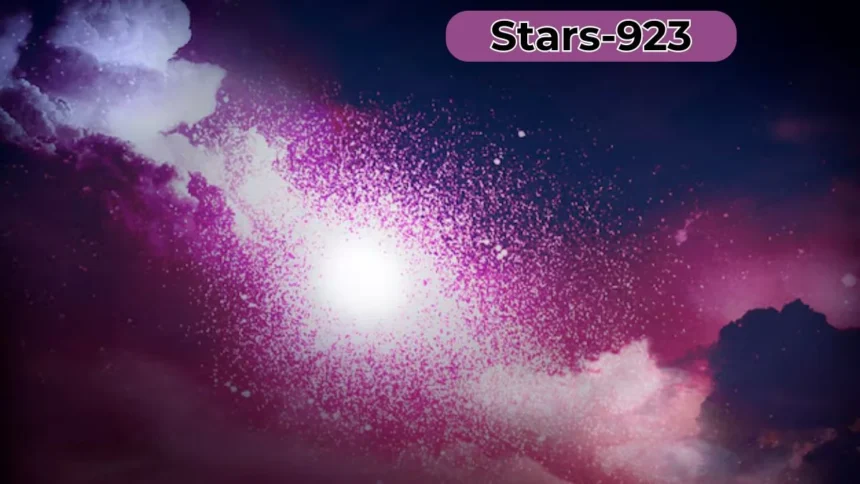Introduction to Stars 923
The universe is a boundless expanse, filled with celestial wonders and enigmatic phenomena. Among these marvels lies Stars-923, an intriguing star system that has captured the imaginations of both scientists and stargazers alike. But what exactly makes this distant wonder so special? With its unique characteristics, fascinating discoveries, and the potential for groundbreaking research, Stars 923 beckons us to explore its mysteries. Join us as we dive into the depths of space to unravel the secrets behind this captivating stellar entity.
The Discovery of Stars 923
Stars-923 was serendipitously discovered by astronomers using advanced telescopes equipped with cutting-edge imaging technology. During a routine survey, the unusual light signature caught their attention.
Initial observations revealed that Stars-923 is located in a distant galaxy, far beyond our Milky Way. Its brightness suggested unique characteristics that warranted further investigation.
Researchers quickly mobilized to gather more data. Spectroscopy played a crucial role in examining its composition and temperature. This breakthrough opened up new avenues for understanding stellar evolution.
The discovery sparked excitement within the scientific community. It raised questions about how such stars form and evolve over time in isolated regions of space. Each finding added another layer of mystery surrounding this celestial wonder, igniting curiosity among both seasoned astronomers and amateur stargazers alike.
Characteristics and Composition of Stars-923
Stars-923, like many distant celestial bodies, possesses fascinating characteristics that intrigue astronomers. This star showcases a brilliant luminosity, suggesting it is significantly larger than our Sun.
Its composition primarily includes hydrogen and helium. These elements are fundamental in the life cycle of stars. The fusion process at its core generates immense energy, driving its brightness.
Spectroscopic analysis reveals unique signatures within Stars 923’s atmosphere. Presence of heavier elements hints at complex chemical processes over eons.
Temperature readings suggest a surface hotter than typical stars in our galaxy. Such extremes contribute to its exceptional behavior and lifecycle patterns.
Furthermore, the star’s distance from Earth raises questions about its age and development stage. Understanding these aspects can unravel deeper cosmic mysteries beyond our immediate observations.
How are Scientists Studying Stars 923?
Scientists are employing advanced telescopic technology to study Stars-923. Ground-based observatories equipped with adaptive optics help reduce atmospheric distortion, providing clearer images of this distant wonder.
Space telescopes like Hubble and the upcoming James Webb Observatory offer unparalleled views. They capture data across various wavelengths, revealing hidden details about its composition and behavior.
Spectroscopy plays a crucial role in analyzing light from Stars-923. By examining how different elements absorb or emit light, researchers can decipher its chemical makeup and temperature.
Moreover, computer simulations model the star’s life cycle based on gathered data. These simulations help predict future behaviors and phenomena associated with Stars-923.
Collaboration among international teams enhances research efforts. Sharing findings accelerates understanding and opens doors for new inquiries into this celestial marvel.
The Implications of Discovering Stars 923
The discovery of Stars-923 opens a new chapter in our understanding of the cosmos. It challenges existing theories about star formation and evolution.
This celestial marvel could provide valuable insights into the life cycles of distant stars. Scientists are keen to explore how its unique characteristics compare with other known celestial bodies.
Moreover, Stars-923 may help refine our models for cosmic distances and ages. Its light carries clues from billions of years ago, allowing us glimpses into the past universe.
The implications extend beyond astronomy; they touch on philosophy and humanity’s place in the universe. As we unravel its mysteries, we may find answers to questions that have long eluded us.
Each observation brings potential revelations about dark matter or even hints at extraterrestrial phenomena. The excitement surrounding Stars-923 is palpable as researchers gear up for more explorations ahead.
What Makes Stars 923 Unique?
Stars-923 stands out in the cosmic tapestry due to its unusual spectral characteristics. Unlike typical stars, it exhibits a remarkable blend of elements that hint at complex formation processes.
Another intriguing aspect is its distance from Earth. At billions of light-years away, studying Stars-923 challenges our understanding of space and time. This isolation makes every data point valuable for astronomers.
Additionally, Stars-923 has unique brightness fluctuations that suggest dynamic activity within its atmosphere. These variations offer clues about stellar evolution and lifecycle stages not commonly observed.
The star’s position within its galaxy also contributes to its uniqueness. Nestled among other celestial bodies, it provides a fascinating case study on gravitational interactions and their effects on stellar behavior.
Together, these factors create an intricate portrait of Stars-923 that captivates both scientists and enthusiasts alike. Each discovery deepens our appreciation for the complexities inherent in the universe’s distant wonders.
Discoveries and Observations of Stars 923
The journey of exploring Stars-923 has revealed fascinating insights. Observations through advanced telescopes have shown that this star system exhibits unusual brightness patterns. These variations hint at complex phenomena taking place.
Data collected by space missions provide a clearer picture of its composition. Scientists are particularly intrigued by the presence of rare elements not commonly found in other stars. This uniqueness opens new avenues for research.
Moreover, recent spectroscopic analyses have unveiled temperature fluctuations within Stars-923. Understanding these changes is crucial for piecing together its lifecycle and evolution.
Astronomers continue to monitor this celestial wonder, gathering real-time data to refine their models and theories. The ongoing discoveries promise to deepen our understanding of stellar behavior across the universe, making Stars-923 an exciting focal point in contemporary astrophysics research.
Theories and Speculations Surrounding Stars-923
The realm of Stars-923 is filled with intriguing theories and bold speculations. Astronomers propose that this distant star could harbor elements unlike any found in our solar system. Some researchers suggest it might be part of a binary system, interacting gravitationally with another celestial body.
There’s also talk of the possibility that Stars-923 could host exoplanets within its habitable zone. This notion fuels imaginations about extraterrestrial life forms thriving under its light.
Another captivating theory revolves around the unique chemical composition observed in Stars-923’s spectrum. Scientists are exploring whether these peculiarities indicate ancient stellar processes or something yet unknown to modern astrophysics.
Debates continue regarding the age and formation history of Stars-923 as well. Each new finding brings fresh questions, pushing scientists to rethink long-held beliefs about star evolution and cosmic interactions. The mysteries surrounding this distant wonder keep both amateurs and experts captivated by what lies beyond our reach.
What Can We Learn from Studying Distant Stars?
Studying distant stars opens a window into the universe’s past. Every light year traveled reveals secrets about stellar evolution and the life cycles of celestial bodies.
By observing these ancient giants, scientists can glean insights into how elements are formed. This helps us understand our own planet’s composition and origins.
Moreover, distant stars serve as cosmic laboratories for testing theoretical models of physics. They challenge our understanding of gravity, fusion processes, and even dark matter.
The diversity found among various star systems inspires questions about the potential for habitable worlds beyond our solar system. Each discovery enriches our knowledge base.
As we peer deeper into space, we also explore human existence within this vast cosmos. The more we learn from these luminous wonders, the better equipped we become to face future challenges on Earth and beyond.
Future Research and Exploration Opportunities with Stars-923
The future of research surrounding Stars-923 is brimming with potential. As technology advances, scientists are poised to unlock even more secrets hidden within this distant stellar phenomenon.
New telescopes and observational technologies will enhance our ability to study its light spectra. This can lead to insights into the chemical composition and age of Stars-923.
Collaboration across international space agencies could pave the way for missions that directly observe these stars. Proposals for unmanned missions are already being discussed in scientific circles.
Furthermore, astrobiology might benefit greatly from studying environments around similar stars. Understanding habitability factors can reshape our perspective on life beyond Earth.
Data-sharing platforms will also enable researchers worldwide to contribute findings in real time. The synergy created by these collaborations could accelerate discoveries exponentially, deepening our understanding of the universe’s fabric through Stars-923.
Conclusion
Stars-923 has captured the attention of astronomers and enthusiasts alike. The journey from its discovery to the ongoing research highlights our desire to comprehend the universe’s vastness. Each characteristic and observation paints a picture of what lies beyond our world.
The implications of studying Stars-923 are profound. It opens doors to understanding stellar evolution, cosmic phenomena, and even the potential for life elsewhere in the universe. As scientists continue their quest for knowledge, they uncover layers of mystery surrounding this distant wonder.
What makes Stars-923 unique is not just its composition but also how it challenges existing theories about star formation and behavior. With every new piece of data collected, we inch closer to answering questions that have puzzled humanity for centuries.
Future exploration opportunities promise exciting advancements in astrophysics and cosmology. Each observation brings us closer together as a global community united by curiosity about what lies beyond our planet’s atmosphere.
As researchers delve deeper into their studies, they inspire future generations to reach for the stars—quite literally—and unravel more mysteries hidden within the cosmos.



